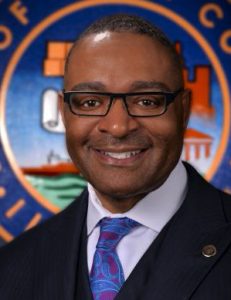Recommendations rolled out to stem Cook County gun violence
By Kevin Beese For Chronicle Media — December 26, 2016Cook County Commissioner Richard Boykin vows to not let the 52-page report from the county’s Gun Violence Task Force be just another well-intended report sitting on an office shelf.
“The fact that we’ve had nearly 5,000 people shot in the city of Chicago in 2016, almost 750 people killed, will help to drive this and some solutions,” Boykin, the force behind creating the task force, said last week in a Cook County Chronicle interview. “It’s ever before us. We cannot afford to have a 2017 like we had a ’16.”
Boykin feels the transparency of the numbers will get people to take action
“Pretty soon the people will speak out and will rise up and will say ‘Wait a minute. Government is failing at its most basic obligation and that is to protect all of the citizens no matter where they live, no matter what ZIP code they live in,’” Boykin said. “They will rise up.”
The report, compiled through 10 months of work, calls for the sharing of information regarding gun-related crimes, more community policing programs and the targeting of crime hot spots. It is also calls for unconventional methods, such as county sheriff’s deputies and Chicago police officers riding on patrols together in targeted areas.
Although there is a task force recommendation for the state General Assembly to create a Crime-related Violence Research Center within the University of Illinois, the task force wanted to generate ideas that would not, for the most part, require state or county legislative approval.
“We started this with the goal of aiming small, not relying on an ineffective Legislature to pass sweeping laws, but instead focusing on evidence-based strategies that we could actually implement to try and curb the gun violence that plagues our streets,” said Cook County Sheriff Tom Dart, a member of the task force. “In a measure of initial success, we’ve already begun implementing a number of the recommendations within the report.”
The task force reported that there is a palpable need for better and more strategic community policing and recommended combining that with evidence-proven tactics such as hot-spot and focus-deterrence policing, where police identify highly specific areas of criminal activity and coordinate practices and resources around those areas.
Task-force members also called for better data-sharing between local agencies, the Illinois State Police and the federal Bureau of Alcohol, Tobacco and Firearms. According to the task force, there is often very little to no inter-agency communication when it comes to firearms, thereby diminishing the ability to effectively understand and police the trafficking of firearms.
“The sheriff’s office and (Chicago police) Supt. Eddie Johnson have been working on rolling out joint efforts between the Chicago Police Department and sheriff’s deputies,” said Sheriff’s Police Deputy Chief Mike Anton, chairman of the task force. “… This type of coordination is something we’ll look to add to in the future.”
Boykin said some of the task force’s recommendations, such as the better sharing of gun-crimes data, should have happened long ago
“Because it is not happening, crimes aren’t being solved,” said Boykin, whose 1st District includes the higher-crime Chicago neighborhoods of Austin and Garfield Park. “You’ve got to make sure the (Chicago Police Department) is sharing with the sheriff’s police, State Police, that everybody’s sharing data. Make sure that municipalities are sharing data with the sheriff’s police and the other law enforcement agencies.”
Boykin noted that the same gun could be used in crimes in both Maywood and Chicago and no connection would be made because no database exists for sharing such information.
“That data doesn’t exist,” Boykin said, “and because it doesn’t exist we aren’t able to solve these crimes.”
Boykin hopes the sheriff’s police teaming with Chicago officers will make the city’s streets safer.
“A lot of it is with this stuff is you’ve got to have a presence, a show of force,” Boykin said. “Sometimes a show of force helps to serve as a deterrent factor against people who do bad things. Also, you’ve got to have a show of force to protect the neighborhoods that are currently in danger, communities under siege because of high unemployment, because of high poverty and high hopelessness.”
Read the current issue of the Cook County Chronicle
Free subscription to the digital edition of the Cook County Chronicle
— Recommendations rolled out to stem Cook County gun violence —







